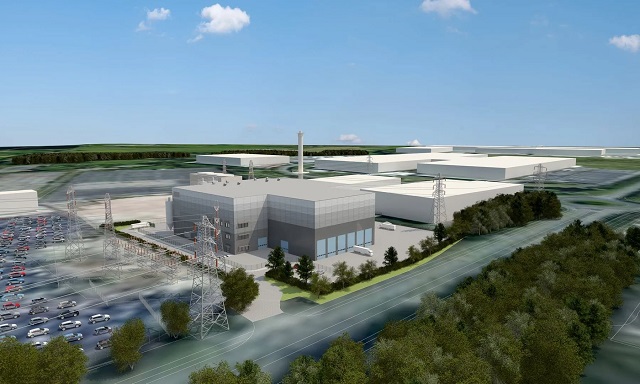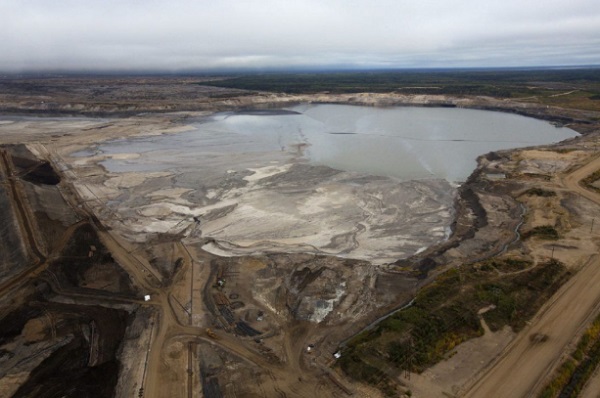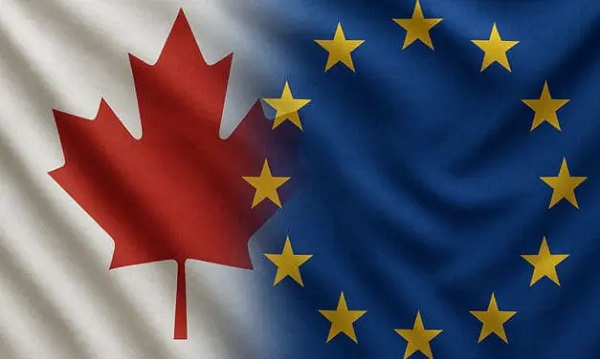Alberta
Alberta announces second waste-to-energy facility near Edmonton to join Central Alberta plant at Innisfail

This waste-to-energy facility also built by Norway’s Varme Energy will be located in an industrial area outside of Birmingham, UK
With $2.8 million from the industry-funded TIER program, Alberta’s government is advancing Canada’s first industrial-scale waste-to-energy facility using technology.
Less than three per cent of municipal waste in Canada is currently being converted into energy, and none of these existing projects are capturing and storing their carbon dioxide emissions. With landfills accounting for 23 per cent of methane emissions in Canada, municipalities and corporations across the country are looking for innovative ways to reach their landfill diversion and sustainability targets.
Alberta’s government is providing $2.8 million through Emissions Reduction Alberta for a $6.1-million front-end engineering and design study led by Varme Energy. This funding helps get Canada’s first facility that uses carbon capture to turn municipal waste into clean electricity closer to construction.
“Alberta is a global leader in carbon capture, utilization and storage technology, and the best place for innovative projects like this one to thrive. Varme Energy is tapping into our province’s exceptional geology, workforce and expertise to advance a landfill elimination solution that will reduce emissions and continue Alberta’s reputation for delivering clean, secure energy to the world.”
“Alberta is a leader in responsible energy development. I am proud to see our government continue to invest in new, innovative technologies that will help ensure our power grid is affordable, reliable and sustainable for generations to come.”
The future facility will be built on Gibson Energy land within the Designated Industrial Zone in Alberta’s Industrial Heartland, with operations estimated to begin in 2027. Here, solid waste from municipal landfills will be converted into electricity for the grid, with the captured carbon injected into one of Alberta’s carbon sequestration hubs. The facility is expected to capture and store about 185,000 tonnes of carbon dioxide annually.
“Emissions Reduction Alberta is proud to provide provincial funding to this first-in-Canada project. The study is an important first step to realizing a large-scale municipal waste-to-energy facility with carbon capture and storage. This project not only reduces emissions, but also sets a new standard for how we provide clean, reliable energy from waste destined for landfills.”
By incorporating carbon capture into the waste-to-energy process, all of the greenhouse gas emissions that are typically released from a waste-to-energy facility will instead be captured and sequestered underground. This helps reduce methane emissions from waste that would normally decompose at the landfill, and ensures all carbon is captured and stored deep in the earth, creating a carbon-negative system where the process stores more carbon dioxide than it emits.
“We are thrilled at how Varme has been embraced by Alberta. The magnitude of support, encouragement and collaboration we’ve received from the Government of Alberta, and Albertans at large, has been beyond our expectations. This direct provincial financial support is a significant de-risk that will help bring our project to a positive final investment decision. Emissions Reduction Alberta’s support demonstrates how Alberta’s TIER carbon pricing system is a powerful tool for converting our historical emissions levies into future emissions reductions, modern jobs and economic activity.”
Quick facts
- Varme Energy’s front-end engineering and design study is expected to be completed in December 2024 with construction set to begin in 2025.
- In addition to provincial funding support through the Technology Innovation and Emissions Reduction (TIER) program, Varme Energy is working with Gibson Energy, the City of Edmonton and the Canada Growth Fund to advance this project, with the ultimate goal of diverting more than 200,000 tonnes of municipal solid waste away from landfills each year.
- Canada currently processes about 26 million tonnes of municipal solid waste annually.
- Through the Alberta Carbon Trunk Line and Quest carbon capture, utilization and storage projects, Alberta has safely sequestered more than 13.5 million tonnes of carbon dioxide to date, which is equivalent to the emissions from 2.9 million cars per year.
- McKinsey projects that annual global investment in carbon capture, utilization and storage could reach $175 billion by 2035, with the majority of these investments in hard-to-abate sectors and the power sector.
Alberta
Alberta health care blockbuster: Province eliminating AHS Health Zones in favour of local decision-making!

Hospital Based Leadership: Eliminating the bureaucratic vortex in hospitals
Since Alberta’s government announced plans to refocus the health care system in November 2023, a consistent message has emerged from patients, front-line health care workers and concerned Albertans alike about the flaws of the prior system. Alberta Health Services’ current zone-based leadership structure is overly complex and bureaucratic. It lacks the flexibility and responsiveness needed to effectively support facilities and staff – particularly when it comes to hiring, securing supplies and adopting necessary technologies.
That’s why Alberta’s government is changing to a hospital-based leadership structure. On-site leadership teams will be responsible for hiring staff, managing resources and solving problems to effectively serve their patients and communities. Hospitals will now have the flexibility to respond, freedom to adapt and authority to act, so they can meet the needs of their facilities, patients and workforce in real time.
“What works in Calgary or Edmonton isn’t always what works in Camrose or Peace River. That’s why we’re cutting through bureaucracy and putting real decision-making power back in the hands of local hospital leaders, so they can act fast, hire who they need and deliver better care for their communities.”
“Hospital-based leadership ensures decisions on hiring, supplies and services are made efficiently by those closest to care – strengthening acute care, supporting staff and helping patients get the timely, high-quality care they need and deserve.”
“By rethinking how decisions are made, we’re working to improve health care through a more balanced and practical approach. By removing delays and empowering our on-site leaders, we’re giving facilities the tools to respond to real-time needs and ultimately provide better care to Albertans.”
AHS’ health zones will be eliminated, and acute care sites will be integrated into the seven regional corridors. These sites will operate under a new leadership model that emphasizes site-level performance management. Clear expectations will be set by Acute Care Alberta, and site operations will be managed by AHS through a hospital-based management framework. All acute care sites will be required to report to Acute Care Alberta based on these defined performance standards.
“Standing up Acute Care Alberta has allowed AHS to shift its focus to hospital-based services. This change will enable the local leadership teams at those hospitals to make site-based decisions in real and tangible ways that are best for their patients, families and staff. Acute Care Alberta will provide oversight and monitor site-level performance, and I’m confident overall hospital performance will improve when hospital leadership and staff have more authority to do what they know is best.”
“AHS is focused on reducing wait times and improving care for patients. By shifting to hospital-based leadership, we’re empowering hospital leaders to make real-time decisions based on what’s happening on the ground and respond to patient needs as they arise. It also means leaders can address issues we know have been frustrating, like hiring staff where they’re needed most and advancing hospital operations. This change enables front-line teams to act on ideas they see every day to improve care.”
The Ministry of Hospital and Surgical Health Services, Acute Care Alberta and Alberta Health Services will work collaboratively to design and establish the new leadership and management model with an interim model to be established by November 2025, followed by full implementation by summer 2026.
Quick facts
- Countries like the Netherlands and Norway, and parts of Australia have already made the shift to hospital-based leadership.
- The interim hospital-based leadership model will be implemented at one site before being implemented provincewide.
- Hospital-based leadership, once implemented, will apply only to AHS acute care facilities. Other acute care organizations will not be affected at the time of implementation.
Related information
Alberta
Alberta is investing up to $50 million into new technologies to help reduce oil sands mine water

Technology transforming tailings ponds
Alberta’s oil sands produce some of the most responsible energy in the world and have drastically reduced the amount of fresh water used per barrel. Yet, for decades, operators have been forced to store most of the water they use on site, leading to billions of litres now contained largely in tailings ponds.
Alberta is investing $50 million from the industry-funded TIER system to help develop new and improved technologies that make cleaning up oil sands mine water safer and more effective. Led by Emissions Reduction Alberta, the new Tailings Technology Challenge will help speed up work to safely reclaim the water in oil sands tailing ponds and eventually return the land for use by future generations.
“Alberta’s government is taking action by funding technologies that make treating oil sands water faster, effective and affordable. We look forward to seeing the innovative solutions that come out of this funding challenge, and once again demonstrate Alberta’s global reputation for sustainable energy development and environmental stewardship.”
“Tailings and mine water management remain among the most significant challenges facing Alberta’s energy sector. Through this challenge, we’re demonstrating our commitment to funding solutions that make water treatment and tailings remediation more affordable, scalable and effective.”
As in other mines, the oil sands processing creates leftover water called tailings that need to be properly managed. Recently, Alberta’s Oil Sands Mine Water Steering Committee brought together industry, academics and Indigenous leaders to identify the best path forward to safely address mine water and reclaim land.
This new funding competition will support both new and improved technologies to help oil sands companies minimize freshwater use, promote responsible ways to manage mine water and reclaim mine sites. Using technology for better on-site treatment will help improve safety, reduce future clean up costs and environmental risks, and speed up the process of safely addressing mine water and restoring sites so they are ready for future use.
“Innovation has always played an instrumental role in the oil sands and continues to be an area of focus. Oil sands companies are collaborating and investing to advance environmental technologies, including many focused on mine water and tailings management. We’re excited to see this initiative, as announced today, seeking to explore technology development in an area that’s important to all Albertans.”
Quick facts
- All mines produce tailings. In the oil sands, tailings describe a mixture of water, sand, clay and residual bitumen that are the byproduct of the oil extraction process.
- From 2013 to 2023, oil sands mine operations reduced the amount of fresh water used per barrel by 28 per cent. Recycled water use increased by 51 per cent over that same period.
- The Tailings Technology Challenge is open to oil sands operators and technology providers until Sept. 24.
- The Tailings Technology Challenge will invest in scale-up, pilot, demonstration and first-of-kind commercial technologies and solutions to reduce and manage fluid tailings and the treatment of oil sands mine water.
- Eligible technologies include both engineered and natural solutions that treat tailings to improve water quality and mine process water.
- Successful applicants can receive up to $15 million per project, with a minimum funding request of $1 million.
- Oil sands operators are responsible for site management and reclamation, while ongoing research continues to inform and refine best practices to support effective policy and regulatory outcomes.
Related information
-

 Health2 days ago
Health2 days agoLast day and last chance to win this dream home! Support the 2025 Red Deer Hospital Lottery before midnight!
-

 conflict1 day ago
conflict1 day ago“Evacuate”: Netanyahu Warns Tehran as Israel Expands Strikes on Iran’s Military Command
-

 Energy1 day ago
Energy1 day agoKananaskis G7 meeting the right setting for U.S. and Canada to reassert energy ties
-

 Alberta2 days ago
Alberta2 days agoAlberta’s grand bargain with Canada includes a new pipeline to Prince Rupert
-

 Business1 day ago
Business1 day agoCarney’s Honeymoon Phase Enters a ‘Make-or-Break’ Week
-

 Aristotle Foundation1 day ago
Aristotle Foundation1 day agoThe Canadian Medical Association’s inexplicable stance on pediatric gender medicine
-

 Business2 days ago
Business2 days agoCarney’s European pivot could quietly reshape Canada’s sovereignty
-

 Energy1 day ago
Energy1 day agoCould the G7 Summit in Alberta be a historic moment for Canadian energy?






